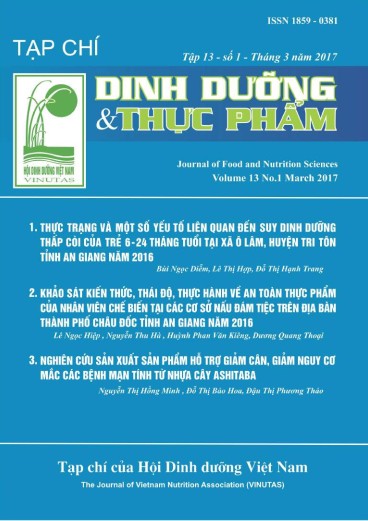EFFECTS Of VIBOZYME SUPPLMENTATION ON EATING DISORDERS, NUTRITIONaL STATUS Of TE CHILDReN aGeD fROM 12 – 36 MONTHS, afTeR USING Of aNTIBIOTIC IN BAC NINH PROVINCE
Main Article Content
Abstract
.
Effects of 2 products richs on micronutrients, plus bio-enzyme and probiotics or riches
on micronutrient alone were inverstigated in children aged from 12-36 month, suffering
from eating disorders after using antibiotics. The data on food consumption, eating disorders and anthropometrics were collected at the 7th, 14th, 21 days of supplementation, and also at day 35 (14 days after stoped of supplementation). The results indicated that the
signs on nutritional disorders, food consumption were ameliored after 14, 21 days utilized
products, then still positive effects after 14 day stoped using products. The Vibozyme products have some better advantage than the 2nd group (rich on micronutrient only). Vibozyme should be used such effect products for tretment and prevention of eating disorders
in children associated with antibiotic utilisation
Keywords
Nalnutrition, eating disorders, antibiotic, micronutrients, probiotic
Article Details
References
2. Nguyễn Thị Vân Anh, Nguyễn Văn Bàng (2007). Khảo sát tình hình sử dụng kháng sinh trong điều trị viêm phổi ở trẻ em tại khoa nhi bệnh viện Bạch Mai, năm 2006. Chuyên đề Nhi Khoa 11(4): 94-97.
3. Barbut F, Meynard JL (2002). Managing antibiotic associated diarrhea. BMJ 324:1345-1346.
4. Fairburn, C., & Beglin, S. (1994). Assessment of eating disorders: Interview or self-report questionnaire? International Journal of Eating Disorders, 16, 363–370.
5. Viện Dinh dưỡng (2016). Số liệu thống kê về tình trạng dinh dưỡng trẻ em qua các năm (1999-2015). http://www.viendinhduong.vn/news/vi/106/61/0/a/so-lieu thong-ke-ve-tinh-trang-dinh-duong-treem-qua-cac-nam.aspx.
6. Nguyễn Thị Hải Hà (2012). Nghiên cứu công nghệ sản xuất và hiệu quả sản phẩm giàu lyzin và vi chất dinh dưỡng đến tình trạng dinh dưỡng và bệnh tật của trẻ em
6-12 tháng tuổi. Luận án Tiến Sỹ Dinh Dưỡng Cộng Đồng, Viện Dinh Dưỡng.
7. Đỗ Thị Phương Hà (2010). Hiệu quả bổ sung men tiêu hóa pepsin tới khả năng tiêu hóa và tình trạng dinh dưỡng của trẻ em 2-5 tuổi. Đề tài cấp viện- Viện Dinh Dưỡng.
8. WHO (1998). Sample size determination in health studies. A pratical manual, Versiton 2. Ed by Lwwanga SK, Lemeshow S, Geneva .
9. Trương Tuyết Mai (2014). Hoàn thiện công thức, qui trình sản xuất và thử nghiệm tính chấp nhận của sản phẩm men vi sinh, enzyme tiêu hóa, lysine và vi chất dinh dưỡng (VIBOZYME) dành cho trẻ biếng ăn và suy dinh dưỡng. Đề tài nghiên cứu khoa học cấp cơ sở - Viện Dinh Dưỡng 2014.
10.Cremonini F, Videlock EJ (2013). Probiotics are associated with a decreased risk of antibiotic-associated diarrhea. Evidensce-based Med 18(2): 71-73.
11.Morelli, Lorenzo; Capurso, Lucio (2012). FAO/WHO Guidelines on Probiotics: 10 Years Later. J Clin Gastroenterology 46:S1-S2.


